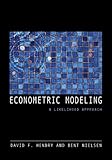Econometric Modeling : A Likelihood Approach / David F. Hendry, Bent Nielsen.
Material type: TextPublisher: Princeton, NJ : Princeton University Press, [2012]Copyright date: ©2007Description: 1 online resource (384 p.) : 50 line illusContent type:
TextPublisher: Princeton, NJ : Princeton University Press, [2012]Copyright date: ©2007Description: 1 online resource (384 p.) : 50 line illusContent type: - 9781400845651
- Econometric models
- Econometrics
- BUSINESS & ECONOMICS / Econometrics
- Accuracy and precision
- Asymptotic distribution
- Autocorrelation
- Autoregressive conditional heteroskedasticity
- Autoregressive model
- Bayesian statistics
- Bayesian
- Bernoulli distribution
- Bias of an estimator
- Calculation
- Central limit theorem
- Chow test
- Cointegration
- Conditional expectation
- Conditional probability distribution
- Confidence interval
- Confidence region
- Correlation and dependence
- Correlogram
- Count data
- Cross-sectional data
- Cross-sectional regression
- Distribution function
- Dummy variable (statistics)
- Econometric model
- Empirical distribution function
- Equation
- Error term
- Estimation
- Estimator
- Exogeny
- Exploratory data analysis
- F-distribution
- F-test
- Fair coin
- Forecast error
- Forecasting
- Granger causality
- Heteroscedasticity
- Inference
- Instrumental variable
- Joint probability distribution
- Law of large numbers
- Least absolute deviations
- Least squares
- Likelihood function
- Likelihood-ratio test
- Linear regression
- Logistic regression
- Lucas critique
- Marginal distribution
- Markov process
- Mathematical optimization
- Maximum likelihood estimation
- Model selection
- Monte Carlo method
- Moving-average model
- Multiple correlation
- Multivariate normal distribution
- Nonparametric regression
- Normal distribution
- Normality test
- One-Tailed Test
- Opportunity cost
- Orthogonalization
- P-value
- Parameter
- Partial correlation
- Poisson regression
- Probability
- Probit model
- Quantile
- Quantity
- Quasi-likelihood
- Random variable
- Regression analysis
- Residual sum of squares
- Round-off error
- Seemingly unrelated regressions
- Selection bias
- Simple linear regression
- Skewness
- Standard deviation
- Standard error
- Stationary process
- Statistic
- Student's t-test
- Sufficient statistic
- Summary statistics
- T-statistic
- Test statistic
- Time series
- Type I and type II errors
- Unit root test
- Unit root
- Utility
- Variable (mathematics)
- Variance
- Vector autoregression
- White test
- 330.015195
- HB141
- online - DeGruyter
| Item type | Current library | Call number | URL | Status | Notes | Barcode | |
|---|---|---|---|---|---|---|---|
 eBook
eBook
|
Biblioteca "Angelicum" Pont. Univ. S.Tommaso d'Aquino Nuvola online | online - DeGruyter (Browse shelf(Opens below)) | Online access | Not for loan (Accesso limitato) | Accesso per gli utenti autorizzati / Access for authorized users | (dgr)9781400845651 |
Frontmatter -- Contents -- Preface -- Data and software -- Chapter One. The Bernoulli model -- Chapter Two. Inference in the Bernoulli model -- Chapter Three. A first regression model -- Chapter Four. The logit model -- Chapter Five. The two-variable regression model -- Chapter Six. The matrix algebra of two-variable regression -- Chapter Seven. The multiple regression model -- Chapter Eight. The matrix algebra of multiple regression -- Chapter Nine. Mis-specification analysis in cross sections -- Chapter Ten. Strong exogeneity -- Chapter Eleven. Empirical models and modeling -- Chapter Twelve. Autoregressions and stationarity -- Chapter Thirteen. Mis-specification analysis in time series -- Chapter Fourteen. The vector autoregressive model -- Chapter Fifteen. Identification of structural models -- Chapter Sixteen. Non-stationary time series -- Chapter Seventeen. Cointegration -- Chapter Eighteen. Monte Carlo simulation experiments -- Chapter Nineteen. Automatic model selection -- Chapter Twenty. Structural breaks -- Chapter Twenty One. Forecasting -- Chapter Twenty Two. The way ahead -- References -- Author index -- Subject index
restricted access online access with authorization star
http://purl.org/coar/access_right/c_16ec
Econometric Modeling provides a new and stimulating introduction to econometrics, focusing on modeling. The key issue confronting empirical economics is to establish sustainable relationships that are both supported by data and interpretable from economic theory. The unified likelihood-based approach of this book gives students the required statistical foundations of estimation and inference, and leads to a thorough understanding of econometric techniques. David Hendry and Bent Nielsen introduce modeling for a range of situations, including binary data sets, multiple regression, and cointegrated systems. In each setting, a statistical model is constructed to explain the observed variation in the data, with estimation and inference based on the likelihood function. Substantive issues are always addressed, showing how both statistical and economic assumptions can be tested and empirical results interpreted. Important empirical problems such as structural breaks, forecasting, and model selection are covered, and Monte Carlo simulation is explained and applied. Econometric Modeling is a self-contained introduction for advanced undergraduate or graduate students. Throughout, data illustrate and motivate the approach, and are available for computer-based teaching. Technical issues from probability theory and statistical theory are introduced only as needed. Nevertheless, the approach is rigorous, emphasizing the coherent formulation, estimation, and evaluation of econometric models relevant for empirical research.
Mode of access: Internet via World Wide Web.
In English.
Description based on online resource; title from PDF title page (publisher's Web site, viewed 01. Dez 2022)


